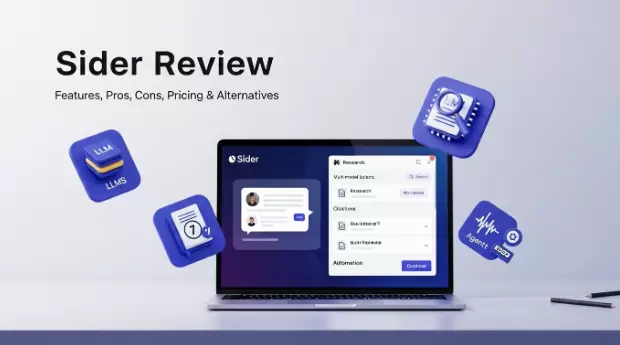In the digital world, simply transferring files securely, orderliness and efficiently is just the beginning of file sharing.
Whether you are a designer passing on large files to clients, or a team collaborating on important documents, the right file sharing application can make your day.
Using email attachments is a thing of the past! With today’s file-sharing software, you can upload, store, and send almost anything online. Many tools feature options like password protection, expiration dates, and collaboration tools; making their use incredibly secure.
As well, you get easy version control, seamless collaboration, secure transmission of sensitive information, and even tracking to see where your files are sent. To be honest, most businesses these days would benefit from using one of these tools.
So, in this guide, we will explore the best file-sharing apps in 2025, to help you find the right solution for your needs, budget, and methods of use.
What to Look For in File‑Sharing Tools
Key features to look for when finding the best file sharing solution for your needs are:
Usability: You want software that is usable and has an interface that doesn't require extensive training. You have to see if it allows you to drag and drop files, it's easy to navigate, and helps users get files shared with the least amount of clicks.
Security features: Cybersecurity is a growing concern, so make sure the software you have in mind has reasonable security features on all of your files. Important security features are end- to-end encryption, password-protection features, access controls, GDPR / HIPAA compliance, and ability to limit time to download files.
File size limits: Different tools have different limits on file sizes. Think about the types of files you normally use, and choose a growth potential platform that can handle your biggest files without having to split or compress them.
Customer Support: Customer support is important when you are a business user to make sure you have support if your files are critical to your business. Look for multiple modes of support on the platform, detailed documentation and responsive customer service.
Storage and retention: You should consider how long the files will be on the platform, if there are download limits, and if you can have a record of files you share permanently.
Best File‑Sharing Tools in 2025
1. WeTransfer
Best for: Creative pros & anyone needing quick, no-fuss transfers
Overview: WeTransfer makes it simple to send files fast. We just need to make an account, and you can do it on your computer and your phone. You can send up to 3 GB at no cost. If you pay for Pro, you get up to 200 GB+ limits and 1 TB of storage, no link expiry and its fine to add your brand to the site. It encrypts the files you send using AES-256, gives you the option to set a password, helps keep track of downloads, and more. It’s a big hit because it is fast, easy, and you can count on it.
Key Features:
- Neo‑minimal UI, no signup required
- Up to 3 GB free (10 transfers/month)
- Password protection, download tracking
- Premium options with 200 GB–unlimited transfers, branding, storage
Pricing:
- Free: 3 GB/month, 10 transfers, 3–7 day expiry
- Starter (~$6.99/mo): 300 GB/month uploads
- Pro (~$12–13/mo): 200 GB uploads, 1 TB storage
- Premium (~$23–24/mo): No limit on uploads, more branding
Pros: Easy-to-use, works fast, good on security, and no account needed for the basics
Cons: Free tier limits transfer count and size; deeper storage requires Pro
2. TransferNow
Best for: Newbies, freelancers and small teamsOverview
Overview: TransferNow has a user-friendly interface that welcomes all techies. It lets you send 5 GB per transfer for free—no account needed—and packs strong security (AES-256, antivirus scans) as well as browser extensions, branded widgets and an API for automation. Plans start offers 500 GB of transfer, more storage, and team functionalities like SSO, dashboard control, and domain customization.
Key Features:
- 5 GB free per transfer
- Password protection, AES‑256 encryption, notifications
- Plugins/extensions (Outlook, Chrome)
- Paid: 250 GB–500 GB transfers, up to 2 TB storage, SSO, domain customization
Pricing:
- Free: 5 GB, 7‑day expiry
- Premium (€6/mo or €144/2‑yr): 250 GB transfers, 500 GB storage
- Team (€18/mo, 10 users): 500 GB transfers, 2 TB storage
- Enterprise: Custom pricing
Pros: Excellent transfer limits for low cost, registration-free core
Cons: Interface less polished than competitors
3. FileTransfer.io
Best for: Students & personal users
Overview: FileTransfer.io is a simple, straightforward, and reliable file sharing platform without any registration required. The free plan has 6 GB file transfers, and they store your files for 21 days. Each link has a limit of 50-downloads, which is very useful if you need to share an assignment or photos. A major plus: upload resumes if interrupted, and password protection comes standard.
Key Features:
- 6 GB max file size (free), 100 GB storage
- Password protection, expiration control, antivirus scanning
- Drag‑and‑drop interface, email links, download tracking
Pricing:
- Free: 6 GB file size, 100 GB storage, 21‑day expiration
- Plus ($9/mo): 25 GB max transfer, 1 TB storage, 90‑day retention
- Business ($49/mo): 100 GB max, 5 TB storage, unlimited retention, file requests
Pros: Generous free allowance, antivirus scanning, detailed tracking
Cons: No API, smaller brand awareness; no free trial for Business tier
4. Smash
Best for: Developers, creatives, large-file users
Overview: Born in Lyon, Smash throws file-size limits out the window. You can instantly upload 50 GB—and even 100 GB+—for free (with priority queuing for Pro). It’s secure (AES encryption), GDPR-compliant, and eco-conscious—plus offers Outlook plugins, an API, branding for pros, admin tools, and team support. Users love its simplicity and developer-friendliness
Key Features:
- Unlimited size on free tier (subject to queue)
- Pro: 250 GB transfers, 1 TB storage, 30‑day availability
- Team: Up to 500 GB transfers, 2 TB storage, SSO, user roles
- AES‑256 encryption, antivirus, Outlook add‑in, API
Pricing:
- Free: 2 GB limit, 7‑day retention
- Pro (€10/mo or €120/yr): 250 GB transfer, 1 TB storage
- Team (€25/mo for 10 users): 500 GB transfer, 2 TB storage, admin tools
- Enterprise: Custom pricing
Pros: Unlimited free transfer, brandable experience, developer-friendly
Cons: Free users may face queuing; higher tiers required for advanced security
How to Choose the Right Tool
Guide your decision through this 4‑step process:
1. Assess needs & budget – Casual user? Team admin? Choose accordingly.
2. Trial key tools – Prove value with free tiers or trials.
3. Read reviews – Look for reliability, support, security feedback.
4. Plan for scalability – Choose tools that expand with your growth (storage, users, API).
5. Send Anywhere
Best for: Anyone who wants quick, cross-device transfers
Overview: Send Anywhere is like AirDrop, but it works everywhere: Android, iOS, Windows, Mac, Linux and even in your browser. Pick a file, get a six digit code or a QR, and your friend can grab it in seconds.
Think of Send Anywhere as AirDrop, It works on Android, iOS, Windows, Mac, Linux and in your browser. You pick a file, get a six-digit code or QR, and boom, your buddy downloads it.
No cloud storage, no sign-up needed—and free transfers go up to 10 GB. Paid plans come up to 200–500 GB, add custom download links, and more. It's fast when you need something quick and direct.
Key Features:
- Peer-to-peer transfer—no files stored on a server
- No registration for core use; just use the code or QR
- Up to 10 GB free (P2P), paid plans increase that limit
- AES encryption, expiring links, multi-platform apps
Pricing:
- Free: up to 10 GB P2P transfers
- Lite ($5.99/mo): 200 GB, faster servers
- Standard ($9.99/mo): 500 GB, full features
Pros:
- Super fast, instant device-to-device
- No sign-up friction
- Strong encryption, works offline over Wi‑Fi Direct
Cons:
- Both devices must be online during transfer
- Free version shows ads and occasional wait times
- Link features need account & paid plan
6. Filemail
Best for: Businesses & power users needing large, trackable transfers
Overview: Filemail is a powerhouse when it comes to sharing massive files—no size limits, fast global delivery, and rich admin capabilities. Send up to 5 GB free, no sign-up required. Premium tiers include features like custom branding, subdomains, upload forms, and full audit logs—plus compliance tools like HIPAA, SSO, and two-factor authentication.
Key Features:
- Unlimited transfers, global CDN, UDP acceleration
- Secure: end‑to‑end encryption, 2FA, virus scanning
- Custom subdomains, branded emails, upload forms
- Desktop, web, and Outlook clients, file request support
Pricing:
- Free: 5 GB transfer, 30-day storage, basic tracking
- Personal/Pro/Business: 250 GB → unlimited sizes, from 250 GB to per‑user TB storage
Pros: Very secure, able to track, ready for the large business
Cons: Paid tiers can be pricey; more features than needed for casual users
7. SendGB (Minimal mention from earlier)
Best for: People who want a fast way to share files with no fuss
Overview: Send GB offers a free plan where you can swap files of up to 5 GB, you can set a password, and you can keep the file for 7 days. It’s lightweight and straightforward—drop your files, share the link.
SendGB allows you to share files up to 5 GB for free, and you can also choose to password protect or set the file to expire in 7 days. It’s simple and easy—just drop your files, share the link.
Pros: Fast, No registration,
Cons: Basic UI, no branding and no advanced admin tools
8. ToffeeShare
Best for: Privacy-focused users wanting peer-to-peer transfers
Overview: ToffeeShare focuses on straight-to device transfers from device to device – no servers, no storage, and no size limits. Files are transmitted directly to the recipient over WebRTC and are end-to-end encrypted, close the browser, and the transfer vanishes.
Key Features:
- Unlimited file size, P2P WebRTC
- End-to-end encryption (DTLS 1.3), no data stored server-side
- Zero registration, extremely privacy-friendly
Pricing: Completely free
Pros: Max privacy, no size caps, eco-conscious design
Cons: Both devices need to be online at the same time; no cloud storage or tracking
9. File.io
Best for: Quick, disposable link sharing
Overview: File.io enables users to upload a file and share a link that is valid for a single download before the file is deleted. Perfect for sending files that you don’t want lingering around.
Pros: Automatic deletion after download, easy to use
Cons: No history, no storage, no team features
10. ShareDrop
Best for: Simple way to share files in the browser
Overview: ShareDrop is a web based, AirDrop like sharing tool built on WebRTC., AirDrop-style sharing tool built on WebRTC. Drag and drop in your browser, devices find each other automatically, and encryption keeps it secure. No downloads, no accounts.
ShareDrop is a web-based WebRTC-based sharing tool similar to AirDrop. It has features such as drag and drop in the browser, automatic device discovery, and secure encryption. No downloads, no accounts.
Pros: Easy browser-based transfers, no registration, secure
Cons: Requires browser support, devices on same network, no cloud storage
Conclusion
File-sharing in 2025 provides the whole gamut of file-sharing capabilities, from quick and easy file transfer to complicated business secure file transfer. Choosing the best one means considering precisely what your needs are. Are you transferring large design files, sharing sensitive documents, or transferring files with code automation? These tools can help you.
Ultimately, it’s a matter of what you need in features, security, usability – and your budget. The file-sharing option you pick should increase your productivity, safeguard your data, and even help you look good. So spend a little time testing some; compare and choose one that feels right for you at this moment and can grow with you.
Frequently Asked Questions :
Q: What's the difference between file sharing software and cloud storage services?
A: File sharing software mainly moves files from one to another. It often gives out links that only work for a set time. Cloud storage services allow for storage for a long time, syncing to more than one computer and for working together.
Q: How secure are free file sharing services?
A: The security of free services varies a lot. Most of them give just the basics. Paid plans often have more security, like password locks, who can see things, and rules for what can be done with the files. For work with a lot of data that has to be safe, pick a paid plan with strong security.
Q: How to share files in Teams for collaboration?
A: Some platforms have some tools for working together or for collaboration. But these are not as good as tools just for working as a team. For a team, pick a site that works together and good at working as a team.
Q: What file size limits should I expect?
A: File size limits vary widely. Free plans typically range from 2 GB to 5 GB per transfer, while paid plans often offer much larger limits or unlimited file sizes. Consider your typical file sizes when choosing a platform.
Q: How long are files typically stored on file sharing platforms?
A: Storage duration varies by platform and plan. Free services often store files for 7–30 days, while paid plans may offer longer retention periods or permanent storage. Some platforms automatically delete files after download for enhanced security.


 Table of Content
Table of Content










